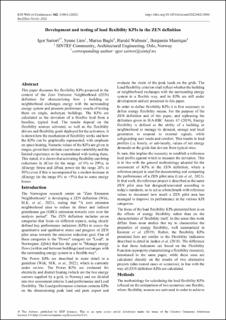| dc.contributor.author | Sartori, Igor | |
| dc.contributor.author | Lien, Synne Krekling | |
| dc.contributor.author | Bagle, Marius | |
| dc.contributor.author | Walnum, Harald Taxt | |
| dc.contributor.author | Manrique Delgado, Benjamin | |
| dc.date.accessioned | 2022-12-05T07:08:36Z | |
| dc.date.available | 2022-12-05T07:08:36Z | |
| dc.date.created | 2022-12-02T09:44:10Z | |
| dc.date.issued | 2022 | |
| dc.identifier.issn | 2267-1242 | |
| dc.identifier.uri | https://hdl.handle.net/11250/3035727 | |
| dc.description.abstract | This paper discusses the flexibility KPIs proposed in the context of the Zero Emission Neighborhood (ZEN) definition for characterizing how a building or neighborhood exchanges energy with the surrounding energy system and presents preliminary results of testing them on single, archetype buildings. The KPIs are calculated as the deviation of a flexible load from a baseline, typical load. The results depend on the flexibility sources activated, as well as the flexibility drivers and flexibility goals deployed for the activation. It is shown how the mechanism of flexibility works and how the KPIs can be graphically represented, with emphasis on space heating. Numeric values of the KPIs are given in ranges, given their intrinsic case to case variability and the limited experience so far accumulated with testing them. This stated, it is shown that activating flexibility can bring reductions in ΔCost (in the range of 0% to 20%), in ΔEnergy Stress and ΔPeak power (in the range 20% to 50%) even if this is accompanied by a modest increase in ΔEnergy (in the range 0% to +5%) due to some energy losses. | en_US |
| dc.language.iso | eng | en_US |
| dc.publisher | E3S Web of Conferences | en_US |
| dc.rights | CC BY 4.0 | * |
| dc.rights.uri | http://creativecommons.org/licenses/by/4.0/ | * |
| dc.title | Development and testing of load flexibility KPIs in the ZEN definition | en_US |
| dc.title.alternative | Development and testing of load flexibility KPIs in the ZEN definition | en_US |
| dc.type | Peer reviewed | en_US |
| dc.type | Journal article | en_US |
| dc.description.version | publishedVersion | en_US |
| dc.rights.holder | © 2022 The authors | en_US |
| dc.subject.nsi | VDP::Teknologi: 500 | en_US |
| dc.source.volume | 362 | en_US |
| dc.source.journal | E3S Web of Conferences | en_US |
| dc.identifier.doi | 10.1051/e3sconf/202236213004 | |
| dc.identifier.cristin | 2087579 | |
| dc.relation.project | Norges forskningsråd: 294920 | en_US |
| dc.relation.project | Norges forskningsråd: 257660 | en_US |
| dc.source.articlenumber | 13004 | en_US |
| cristin.ispublished | true | |
| cristin.fulltext | original | |
| cristin.qualitycode | 1 | |

